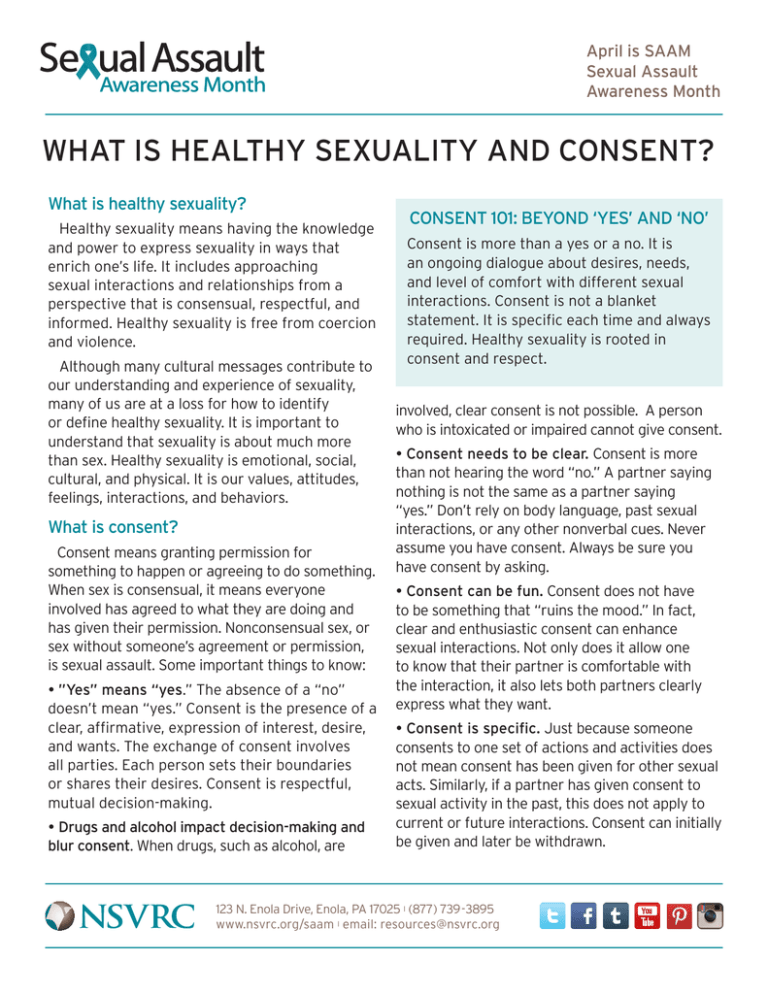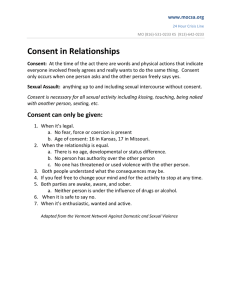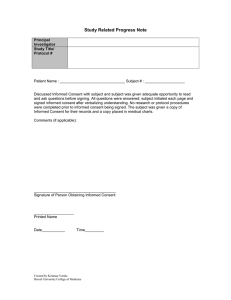
April is SAAM
Sexual Assault
Awareness Month
WHAT IS HEALTHY SEXUALITY AND CONSENT?
What is healthy sexuality?
Healthy sexuality means having the knowledge
and power to express sexuality in ways that
enrich one’s life. It includes approaching
sexual interactions and relationships from a
perspective that is consensual, respectful, and
informed. Healthy sexuality is free from coercion
and violence.
Although many cultural messages contribute to
our understanding and experience of sexuality,
many of us are at a loss for how to identify
or define healthy sexuality. It is important to
understand that sexuality is about much more
than sex. Healthy sexuality is emotional, social,
cultural, and physical. It is our values, attitudes,
feelings, interactions, and behaviors.
What is consent?
Consent means granting permission for
something to happen or agreeing to do something.
When sex is consensual, it means everyone
involved has agreed to what they are doing and
has given their permission. Nonconsensual sex, or
sex without someone’s agreement or permission,
is sexual assault. Some important things to know:
”Yes” means “yes.” The absence of a “no”
doesn’t mean “yes.” Consent is the presence of a
clear, affirmative, expression of interest, desire,
and wants. The exchange of consent involves
all parties. Each person sets their boundaries
or shares their desires. Consent is respectful,
mutual decision-making.
Drugs and alcohol impact decision-making and
blur consent. When drugs, such as alcohol, are
CONSENT 101: BEYOND ‘YES’ AND ‘NO’
Consent is more than a yes or a no. It is
an ongoing dialogue about desires, needs,
and level of comfort with different sexual
interactions. Consent is not a blanket
statement. It is specific each time and always
required. Healthy sexuality is rooted in
consent and respect.
involved, clear consent is not possible. A person
who is intoxicated or impaired cannot give consent.
Consent needs to be clear. Consent is more
than not hearing the word “no.” A partner saying
nothing is not the same as a partner saying
“yes.” Don’t rely on body language, past sexual
interactions, or any other nonverbal cues. Never
assume you have consent. Always be sure you
have consent by asking.
Consent can be fun. Consent does not have
to be something that “ruins the mood.” In fact,
clear and enthusiastic consent can enhance
sexual interactions. Not only does it allow one
to know that their partner is comfortable with
the interaction, it also lets both partners clearly
express what they want.
Consent is specific. Just because someone
consents to one set of actions and activities does
not mean consent has been given for other sexual
acts. Similarly, if a partner has given consent to
sexual activity in the past, this does not apply to
current or future interactions. Consent can initially
be given and later be withdrawn.
123 N. Enola Drive, Enola, PA 17025 l (877) 739-3895
www.nsvrc.org/saam l email: resources@nsvrc.org
April is SAAM
Sexual Assault
Awareness Month
KEY CHARACTERISTICS:
HEALTHY SEXUALITY
The following behaviors are adapted from the
Sexuality Information and Education Council
of the United States’ Life Behaviors of a
Sexually Healthy Adult (SIECUS, 2004, p. 16):
• Comfortable with their body.
• Know that human development includes sexual
development, which may or may not include
reproduction or sexual experience.
• Have access to information and resources to
protect and enhance their own sexual health.
• Engage in sexual relationships that are
consensual, non-exploitative, honest,
pleasurable, and safe.
• Express their sexuality while respecting the
rights of others.
• Interact with all genders and gender identities
in respectful and appropriate ways.
• Know the difference between life-enhancing
sexual behaviors and those that are harmful to
self and/or others.
• Communicate well with family, peers, and
romantic partners.
Establishing consent
Remember that sex without consent is sexual
assault. When establishing consent, be aware of
the following:
Ask for consent. Don’t assume a partner is
OK with what you want to do. Always ask them.
Be direct. If you are unsure that you have their
consent, ask again.
Communicate. Don’t be afraid to talk about sex
and communicate your boundaries, wants, and
needs. Encourage your partner to do the same.
Make it fun. Consent does not have to be
something that interrupts sex; it can be a part of
sex. Checking in with your partner throughout
sexual experiences can be a great way to build
intimacy and understand your partner’s needs. It
can help partners create a healthy and satisfying
sex life.
Drugs and/or alcohol increase risk.
Intoxication impairs decision-making and can
make it impossible to gain someone’s legal
consent. Mixing drugs and/or alcohol with
sex also can lead to risky behavior, such as
unprotected sex.
• Express their sexuality in ways that are in line
with their values.
Resources
• Enjoy sexual feelings without necessarily acting
on them.
National Sexual Violence Resource Center:
www.nsvrc.org
• Understand the impact of family, cultural,
media, and societal messages on thoughts,
feelings, values, and behaviors.
• Accept one’s own sexual orientation and
respect the sexual orientations of others.
• Accept one’s own gender identity and respect
the gender identities of others.
The Line Campaign: www.whereisyourline.org
• Scarleteen: www.scarleteen.com
• Yes Means Yes: yesmeansyesblog.wordpress.com
References
Sexuality Information and Education Council of the United
States. (2004). Life behaviors of a sexually healthy adult.
Retrieved from http://faculty.plts.edu/gpence/PS2010/
html/LifeBehaviorsofaSexuallyHealthyAdult.pdf.
© National Sexual Violence Resource Center 2015. All rights reserved.





